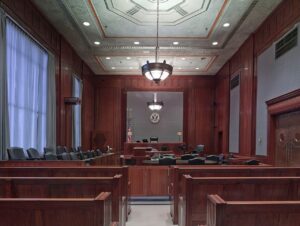11 Wake Forest L. Rev. Online 1 (Opens PDF in new tab)
Andrea A. Anderson*
I. Introduction
Kenneth was a coal miner.[1] One day, while cooling a welding area, a hose burst and severely injured his neck and face.[2] Despite sustaining major injuries that would prevent him from working in the future, Kenneth had limited legal options to pursue compensation.[3] For example, workers’ compensation law protected his employer, the coal company, from lawsuits by employees.[4] Kenneth’s best option was to bring a products liability claim against the manufacturer and distributor of the welding hose.[5] When Kenneth asked his employer for the hose so that he could investigate the cause of his injuries, his employer refused.[6] The employer also refused to reveal the identity of either the manufacturer or distributor of the hose.[7] After further investigation, Kenneth learned that his employer intentionally destroyed the hose after it had allowed the manufacturer and distributor to inspect it for their own legal defense.[8] Perhaps even more troubling, Kenneth learned that the distributor was a subsidiary of the employer coal company.[9] Frustrated with the unfair actions of the coal company and unable to pursue his products liability claim, Kenneth filed suit against his employer for intentional spoliation of evidence.[10]
Spoliation tort claims hold an individual liable in damages for the destruction of evidence critical to another’s legal claim. The tort serves as an alternative to the traditional evidentiary approach to spoliation.[11] In the traditional approach, parties claiming spoliation are limited to trial sanctions ranging from an inference that the destroyed evidence would have been adverse through the complete dismissal of a suit.[12] In the tort suit, by contrast, a plaintiff is not limited to trial remedies and may seek full compensation for the underlying lawsuit.[13]
Courts and legal scholars categorize spoliation claims by the level of intent of the spoliator and the party’s relation to the underlying lawsuit.[14] Spoliation claims may be brought against primary parties to the underlying suit or third parties to the litigation.[15] Additionally, plaintiffs may allege that the spoliator negligently or intentionally destroyed evidence necessary for the litigation.[16] This categorization results in four overall forms of spoliation claims: first-party negligent, first-party intentional, third-party negligent, and third-party intentional destruction of evidence.[17]
An independent spoliation cause of action is relatively novel. In 1984, the California Court of Appeals was the first court to allow an independent spoliation claim.[18] Afterwards, additional state courts began following suit and recognized independent forms of spoliation within their own jurisdictions.[19] In the thirty-six years since the first case in California, thirty-three states have considered an independent spoliation claim.[20] Nineteen states declined to recognize a spoliation tort, and fourteen states recognized at least one form of the claim.[21]
Of the forms of spoliation, third-party intentional claims enjoy the largest support amongst courts. Most recently, the Idaho Supreme Court formally recognized third-party intentional spoliation in October of 2019.[22] This Comment argues that third-party intentional claims are necessary and viable tort claims within the scheme of American civil litigation.
Third-party intentional spoliation claims are necessary to provide a remedy for the victim. While sufficient trial sanctions exist to deter and remedy spoliation committed by first parties, such remedies are not available against third parties who interfere with a litigant’s ability to seek justice under the court system.[23] Currently, states provide limited misdemeanor charges against third parties who are under a court order to preserve evidence and subsequently destroy or lose the material.[24] Such consequences are only available in narrow circumstances, insufficiently deter spoliation, and fail to provide the victim with any remedy in its underlying lawsuit. Thus, third-party spoliation claims are necessary to provide a remedy where current law is lacking.
Third-party intentional claims are viable because they advance the tort goals of deterrence and morality. When an individual takes intentional steps to interfere with a viable claim, he measures the cost and benefits to the action.[25] Knowing that spoliation is only found in the most fortuitous of circumstances and most cases settle before the discovery of such malfeasance,[26] the intentional spoliator takes a calculated risk that is purely aimed at self-interest at the expense of truth and justice. Such immoral and intentional interference cannot be tolerated in our courts and should be addressed with a cause of action.
As Kenneth the coal miner’s case illustrates, third-party intentional spoliators are rarely true strangers to the underlying litigation. Third parties who intentionally destroy evidence often have some pecuniary or personal interest in the lawsuit.[27] Faced with minimal consequences, there is little deterrent for interested third parties to exercise their traditional property rights and dispose of their own property at will. As courts and legal scholars wrestle with the issue of independent spoliation claims, they should choose to adopt and affirm the viability and necessity of third-party intentional spoliation claims.
Part II of this Comment will trace the evolution of independent tort claims from its beginning in California courts through its current acceptance across the fifty states and the District of Columbia. Part III of this Comment will present arguments in favor of the necessity and viability of third-party intentional claims. Part III.A will explain that third-party intentional claims conform with tort law principals. Part III.B will explain the fundamental errors in court opinions rejecting third-party intentional spoliation and will examine successful frameworks used in states that recognize independent spoliation.
II. Background
A. Historical Development of Spoliation of Evidence as a Tort
1. Spoliation as an Evidentiary Issue
The concept of spoliation has its roots in English common law. Its origin is often traced back to Amory v. Delamirie,[28] a 288-year-old case of a chimney sweep who found a jeweled ring while performing his work.[29] In Amory, the sweep brought the jewel to a goldsmith who, under the pretense of evaluating the jewel, took it from the sweep and refused to return it.[30] The sweep brought a common law claim of trover against the goldsmith, but the goldsmith refused to produce the jewel at trial.[31] The court directed the jury that “unless the [goldsmith] did produce the jewel, and shew it not to be of the finest water, they should presume the strongest against him, and make the value of the best jewels the measure of their damages.”[32] This jury instruction represents what the American legal system would later call an adverse inference in favor of the victim of spoliation.
Under American law, spoliation of evidence is largely treated as an evidentiary matter that the court addresses through sanctions. The Federal Rules of Civil Procedure, for example, impose a variety of sanctions for first-party spoliation.[33] Courts will fashion the intensity of the sanction to the level of intent of the spoliator.[34] State courts follow a similar pattern when addressing first-party spoliation. State courts largely treat spoliation as an evidentiary matter, and they enjoy great discretion in determining the just remedy for each case of spoliation. For example, in Maryland, “[t]he destruction or alteration of evidence by a party gives rise to inferences or presumptions unfavorable to the spoliator, the nature of the inference being dependent upon the intent or motivation of the party.”[35] Under Florida law, a court may even sanction an offending party by establishing a rebuttable presumption of negligence and liability.[36] Massachusetts and Minnesota take a slightly different approach. Instead of tailoring the spoliation sanction to the level of culpability in the offending party, those states instruct judges to select a remedy that will address the level of prejudice suffered by the innocent party.[37]
Compared to the wealth of tools to address first-party spoliation, there are relatively limited remedies against third parties who destroy evidence. Under several state laws, a third party who destroys evidence may be subject to criminal liability. For example, under California law, it is a misdemeanor offense to destroy evidence that a court has ordered a stranger to the action to preserve for litigation.[38] In Delaware, a state statute made it a class G felony to conceal, alter, or destroy evidence by any person, primary parties to the litigation or third parties.[39]
States have traditionally used evidentiary sanctions to deter and remedy spoliation. Though courts have the greatest flexibility when addressing spoliation by a first party, court orders and criminal charges are also available against third parties who destroy evidence.
B. Spoliation as an Independent Tort
The evidentiary approach, however, is not the only way that a court may deter and remedy the destruction of evidence that is essential to a civil suit’s just resolution.
1. Spoliation Tort Birth and California’s Expansive Phase
California was the first state to recognize an independent claim for spoliation in Smith v. Superior Court.[40] In Smith, the plaintiff was permanently blinded when a wheel and tire detached from another motorist’s van and collided with her windshield.[41] After the accident, the van was towed to the dealer’s repair shop who agreed to preserve parts of the van for inspection.[42] Unfortunately, the dealer shop later destroyed or lost the parts, and the plaintiff sued the dealer for “Tortious Interference with Prospective Civil Action By Spoliation of Evidence.”[43]
California’s Second District Court of Appeals noted that “California has long recognized [for] every wrong there is a remedy.”[44] The court believed recognition of a novel, independent tort was necessary to deter future acts of intentional spoliation.[45] Responding to arguments that assessing damages would be impermissibly speculative, the court quoted a United States Supreme Court holding that not all tort damages must be proven with certainty.[46]
Where the tort itself is of such a nature as to preclude the ascertainment of the amount of damages with certainty, it would be a perversion of fundamental principles of justice to deny all relief to the injured person, and thereby relieve the wrongdoer from making any amend for his acts. In such case, while the damages may not be determined by mere speculation or guess, it will be enough if the evidence show the extent of the damages as a matter of just and reasonable inference, although the result be only approximate.[47]
The defendant argued that the tort of intentional spoliation of evidence was precluded by a state statute imposing a misdemeanor criminal punishment for the act.[48] The court rejected the defendant’s argument and noted that other state criminal statutes gave rise to a civil cause of action.[49] The court further analogized intentional spoliation of evidence to the tort of intentional interference with prospective business advantage.[50] The court ultimately concluded that the claim was necessary to protect the legal interests of a litigant in the value of his probable expectancy of the underlying suit and crafted a claim for intentional spoliation of evidence.[51] Shortly after Smith, the California Second District Court of Appeals recognized an independent tort of negligent spoliation of evidence.[52]
In the next decade, four more states would formally recognize an independent spoliation tort. Two years after Smith, the Supreme Court of Alaska formally recognized the tort of first-party spoliation.[53] In 1993, the Ohio Supreme Court answered certified questions from a federal court regarding Ohio’s recognition of spoliation actions.[54] Without providing detailed reasoning, the court officially recognized an independent tort for intentional spoliation against first- and third-party spoliators.[55] Two years later, the Illinois and New Mexico supreme courts recognized negligent spoliation claims under their existing tort law structures.[56] In the spring of 1998, the District of Columbia also recognized negligent spoliation claims against third parties.[57] The District of Columbia would thus become the first jurisdiction to create a stand-alone negligent spoliation tort with elements distinct from traditional negligence law.
2. California’s Restrictive Phase and the Continued Growth of Spoliation Claims
Just two months after the District of Columbia recognized spoliation, the Supreme Court of California changed direction and severely limited the availability of independent spoliation claims.[58] In Cedars-Sinai Medical Center v. Superior Court,[59] the plaintiff alleged the defendant hospital intentionally destroyed medical records to prevent the plaintiff from prevailing in his medical malpractice claim.[60] The court explained that deterrence of spoliation alone was insufficient to justify the recognition of a novel tort.[61] Instead, the court would only recognize the claim if it “would ultimately create social benefits exceeding those created by existing remedies for such conduct, and outweighing any costs and burdens it would impose.”[62] The court was most concerned with three issues: (1) the potential for endless litigation in recognizing a derivative tort action for misconduct associated with an underlying suit; (2) the strength of already existing remedies; and (3) the uncertainty in assessing damages.[63] The court held that there was no cause of action for first-party spoliation of evidence where the party knew of the destruction before the conclusion of the initial lawsuit.[64]
One year after Cedars-Sinai, the Supreme Court of California rejected its recognition of third-party intentional spoliation in Temple Community Hospital v. Superior Court.[65] The court explained that it would be an anomaly “for a nonparty to be liable in damages, including punitive damages for conduct that would not give rise to tort liability if committed by a [primary] party” to the litigation.[66] The court again reiterated its concern over the speculative nature of damages in spoliation claims and noted that causation in such claims was similarly speculative.[67] Re-emphasizing the court’s concern with duplicative litigation and inconsistent jury determinations, the court believed that third-party claims posed an even greater burden to the judicial system because it would substantially enlarge the class of plaintiffs.[68]
The California Supreme Court rejected the Second District’s reasoning that spoliation was analogous to interference with prospective economic advantage.[69] Under California common law, interference with prospective economic advantage is not viable under circumstances that present speculative claims such as sporting contracts and governmental licensing.[70] Because spoliation claims are inherently speculative, they do not fall within the class of economic interests protected by California common law.[71]
Finally, the California Supreme Court reasoned the lack of remedies against third parties was an insufficient argument to recognize an independent spoliation claim.[72] The court found existing criminal sanctions were sufficient to address third-party spoliation and rejected the claim.[73] After acknowledging that fewer remedies were available for third-party spoliation, the court held that it was ultimately a matter for the legislature to draft additional protections into the law and the burden of private parties to ensure conservation of evidence through contractual agreements.[74]
After Cedars-Sinai and Temple, California courts were increasingly hostile towards independent spoliation claims. The Second District Court of Appeals retreated from leading the state in recognizing spoliation claims and declared it would not recognize first- or third-party spoliation of evidence as independent torts.[75] The Third and Fourth Districts followed suit and also declined to recognize independent claims for negligent spoliation of evidence.[76]
Despite California’s dramatic shift, states continued to formally recognize independent spoliation claims. In the next twenty years, Alabama, Connecticut, Florida, Idaho, Louisiana, Montana, New Jersey, and West Virginia would all recognize independent spoliation actions.[77]
3. States Continue to Recognize the Necessity and Viability of Independent Spoliation Claims
Most recently, in Raymond v. Idaho State Police,[78] Idaho recognized intentional spoliation in October 2019.[79] In Raymond, the plaintiff’s father, Barry Johnson, was killed in a car accident. The accident occurred when a police officer tried to pass Johnson while driving at a very high speed in the left lane while Johnson was making a lawful left turn into his driveway.[80] The state police investigated the accident, and though the driving officer was charged with manslaughter, the charges were ultimately dismissed.[81] The daughter brought suit against the state and county alleging two claims: wrongful death and intentional interference with prospective civil litigation.[82]
The pleadings in Raymond reflect the philosophical divide between courts that endorse the recognition of tort spoliation and those that do not. The plaintiff argued that the state should adopt third-party spoliation claims in order “to protect plaintiffs from third-party misconduct because existing nontort remedies are insufficient and do not serve as adequate deterrents.”[83] On the other hand, the defendant argued that the state should not adopt the tort because it would lead to endless and burdensome litigation, and existing remedies sufficiently deter the destruction of evidence.[84]
The Supreme Court of Idaho agreed with the plaintiff and formally adopted the tort of “intentional interference with a prospective civil action by spoliation of evidence by a third party.”[85] The court supported its decision with two policy justifications: remedy and deterrence.[86] Unlike first-party spoliation, the court believed traditional non-tort remedies to deter destruction of evidence by third parties provided an inadequate remedy for victims.[87] Third parties are not subject to the same evidentiary inferences and discovery sanctions used to remedy destruction of evidence by first parties.[88] Further, the court argued, attorney sanctions against third parties provided only minimal and insufficient deterrence.[89] Thus, by limiting the tort to third parties, the court believed it was creating an enhanced deterrent and providing a remedy to victims that would otherwise not have one.[90] Finally, the court argued, that by limiting the claim to intentional interference, it was not only providing a remedy for the victim, but addressing acts that “are ultimately an affront to the judicial process as a whole.”[91]
Courts in Hawaii, Kansas, Missouri, Oklahoma, Utah, Vermont, and Virginia have considered independent spoliation claims, but rejected the individual case on its facts without affirming or rejecting a spoliation tort.[92] Within those opinions, courts continued to express approval of third-party intentional spoliation claims.[93] Eighteen states have yet to consider independent spoliation claims but may do so in the future as litigants continue to seek remedies for interference with their legal rights.
III. Analysis
The value and recognition of independent spoliation claims remains hotly contested. The majority of state courts that have considered the issue have followed Cedars-Sinai and declined to recognize the claim. However, as is clear from the trend in case law, the California Supreme Court’s change in position did not stem the tide in recognition of spoliation torts. Just last year, the Idaho Supreme Court joined the ranks of state courts that found the claim valid and necessary under its state legal system.
This Comment argues that state courts should continue to recognize spoliation claims, but under narrow circumstances. Because existing court sanctions properly address both negligent and intentional first-party spoliation, no such independent claim is necessary to deter or remedy destruction of evidence by primary parties. Additionally, holding third parties liable for negligent destruction of evidence would not be viable under the American legal system, where property owners generally enjoy the right to use and destroy personal property at will.[94] Imposing an affirmative duty to preserve evidence on a third party would violate his property rights and impose a burden of predicting future litigation between parties other than himself.[95] Thus, third-party negligence claims, though perhaps necessary in our system for lack of adequate remedies, are nonviable because the claims violate other established legal principles.
Third-party intentional claims, by contrast, are necessary and viable under the American legal system. A third party who destroys evidence, with the intent of interfering with another’s lawsuit, commits a flagrant affront to the judicial system. Our current legal system provides inadequate deterrence for such intentional spoliation in the form of weak criminal misdemeanor sanctions. Further, the judicial system leaves the victim of such spoliation without any form of remedy, as traditional discovery sanctions are unavailable against a third party. Thus, this Comment argues that third-party spoliation claims are necessary to provide a remedy to the victim and provides an analysis of state spoliation frameworks that are viable under American civil law.
A. Recognition of Third-Party Intentional Spoliation Claims is Consistent with the Fundamental Goals of Law
In 2003, the West Virginia Supreme Court recognized all forms of spoliation except first-party negligent claims.[96] The court reached its decision by analyzing each form of the claim under the goals of tort law: deterrence, compensation, and morality.[97] Applying this analytical framework, it is clear that third-party intentional spoliation claims are consistent with the fundamental goals of tort law.
Deterrence and compensation weigh heavily in favor of recognizing third-party intentional spoliation claims. Trial courts are generally given great discretion in selecting the appropriate sanction for first-party spoliation and will tailor the remedy according to the fault of the party destroying evidence.[98] Third parties, by contrast, are not subject to the same trial sanctions and consequences. Though some states impose misdemeanor charges for third parties who fail to comply with a court order to preserve evidence,[99] there is no penalty for destroying evidence before litigation begins or before the court issues an order. As argued in Smith, “[i]f crucial evidence could be intentionally destroyed by a party to a civil action who thereby stands to gain substantially monetarily by such destruction, the effect of a misdemeanor would be of minimal deterrence.”[100]
Further, there is no form of compensation for the victim of third-party destruction of evidence because the court will not sanction an innocent first-party litigant for the behavior of a third party. Thus, the goal of compensation and deterrence weighs in favor of recognizing third-party intentional claims.
Traditionally, the core of tort law was morality.[101] When courts determined liability for actions, the morality of the tortfeasor’s act was the predominant factor in their analyses.[102] Professor Charles Nesson discussed the intentional spoliator as an immoral man.[103] After looking at the relevant case law, Professor Nesson discovered a disturbing pattern: spoliation is generally discovered only in the most fortuitous of circumstances.[104] He hypothesized that as a result of its low rate of discovery, a victim of spoliation may not discover the destruction until well into the litigation or even after trial.[105] However, most civil claims will settle before the resolution of the suit.[106] Thus, as Professor Nesson argues, the intentional spoliator adopts a “potent strategy: suppress [i.e., spoliate] and settle.”[107] The intentional spoliator acts immorally as he takes a calculated risk to interfere with another’s right to seek justice under the legal system in hopes of reaping some tangible benefit.
As concluded by legal scholars and the West Virginia Supreme Court, spoliation claims are necessary and viable under the American legal system because they enforce morality, deter wrongdoing, and compensate victims.
B. The Temple Decision is Fundamentally Flawed
The Supreme Court of California did not fairly represent the nature of a third-party intentional spoliation tort in Temple. Temple reasoned that spoliation claims are not viable because damages are impermissibly speculative.[108] However, other states who have recognized spoliation have created workable standards for spoliation that fall within United States Supreme Court guidance. Similarly, Temple reasoned that causation in spoliation claims is overly speculative.[109] However, a study of other jurisdictional case law reveals multiple frameworks for causation that a court may adopt to avoid arguments of speculation. Finally, Temple reasoned that allowing claims against third parties would create a substantial burden on the litigation system by enlarging the class of available plaintiffs.[110] However, no such pattern has been seen in any state that allows third-party intentional claims, and justices within California disagreed with Temple’s assertion. Contrary to Temple, third-party intentional spoliation claims are necessary and viable under American civil law.
1. Temple Incorrectly Represented the Nature of Tort Spoliation Damages and Suggested Frameworks
In Temple, the court criticized Smith’s analogy of intentional spoliation to a claim for intentional interference with prospective economic advantage.[111] Other state courts, however, have affirmed this interpretation of spoliation. New Mexico courts, for example, also recognize intentional spoliation as within the class of economic torts.[112] In its decision to recognize third-party intentional spoliation, the New Mexico Supreme Court explained the use of the judicial system and potential recovery in a lawsuit was an economic interest entitled to protection.[113] In a later case, the New Mexico Supreme Court affirmed its view of spoliation torts and explained that its “primary goal in adopting a separate cause of action for intentional spoliation was not to vindicate the interests of the courts in preventing litigation-related fraud . . . [but was] to protect litigants’ and potential litigants’ prospective right of recovery in civil actions.”[114]
The argument against spoliation as an economic tort in Temple is merely a reiteration of the California Supreme Court’s critique of spoliation damages in Cedars-Sinai.[115] Under California law, the Temple court reasoned, the economic tort was not viable because damages were impermissibly speculative.[116] However, as explained by both the earlier Smith case and—more recently—the Idaho Supreme Court, spoliation damages are not so indeterminant as to cross the threshold into impermissible speculation.[117]
States that recognize spoliation claims created workable frameworks to assess damages. One such framework, used in Alabama, Connecticut, and West Virginia, allows the plaintiff to recover the full value of the underlying lawsuit.[118] This framework is the most concrete way of assessing spoliation damages. In these states, so long as the plaintiff successfully shows all other elements of spoliation, there arises a rebuttable presumption that—but for the spoliation—the plaintiff would have recovered the full value of the underlying suit.[119] The juries need not employ mathematical probabilities to assess the damages, and plaintiffs need not spend additional funds on damages experts. Instead, the damage sum is set at the time of pleading.
Another form of damages in spoliation claims avoids the issue of speculation by providing an instruction to the jury to multiply the possible award in the underlying suit by the probability that the plaintiff would have won the claim if he had access to the evidence.[120] This form of damages is factual, and thus inherently more speculative than the full recovery standard. However, the determination of damages is still within the bounds of the United State Supreme Court precedent in Story Parchment Co. v. Paterson Parchment Paper Co.[121] Story Parchment only prohibits damages based on mere speculation or guess.[122] The Supreme Court instructs that it is enough that the damages are a matter of just and reasonable inferences.[123] Requiring a jury to assess the probability that a litigant would have prevailed on a claim and multiplying that by a known sum is not a mere guess. It is the result of a reasonable inference and designed to bring justice to a party who has been deprived a legal right.
Thus, there are several ways to assess damages in a spoliation claim that are not speculative. Instead of the Temple decision, courts considering the viability of spoliation claims should adopt one of the other models developed in other state supreme court decisions.
2. Temple Incorrectly Represented the Nature of Causation in Tort Spoliation and Suggested Frameworks
In Temple, the California Supreme Court argued that independent spoliation claims require the jury to make a speculative guess as to causation.[124] Namely, the claims require a jury to speculate as to the effect of the evidence on the underlying suit without a means to determine the actual content of the evidence.[125] The nature of spoliation claims makes it impossible for the jury to assess what the evidence actually contained and whether its absence was the cause in fact of the failed lawsuit.[126] However, states who have adopted spoliation as an independent tort have created successful ways to assess causation within the claims.[127] In general, states have adopted one of two viable frameworks for causation: (1) a summary judgment standard and (2) a significant impairment standard.
Under the summary judgment standard, a plaintiff needs to show that the evidence was so critical to the underlying action, that without it, the claim could not or did not survive a summary judgment challenge.[128] Because survival of summary judgment requires a showing that there exists no genuine dispute of material fact, a party claiming spoliation in these states must essentially show the destroyed evidence was critical to the underlying suit. Without that evidence, the party would have no other evidence to meet its burden of production on an essential element of the underlying claim.[129] However, under this standard, the plaintiff need not show the underlying claim would have ultimately been successful with the evidence. Thus, the summary judgment standard avoids speculation on the actual effect the underlying evidence would have had on the success of the suit. Instead, the standard requires only that the plaintiff show the destruction interfered with its burden of production.
Under the significant impairment standard, causation requires a showing of a significant possibility of success in the underlying suit and that the destruction of the evidence caused a significant impairment in pursuing the claim.[130] In Holmes, the court rejected a standard that would require plaintiffs to show they would have prevailed on the underlying claim by a preponderance of the evidence.[131] The court reasoned that such a standard was unreasonably high and failed to protect the unique circumstances of a spoliation victim.[132] Such a standard would essentially require that the plaintiff prove the initial lawsuit in its entirety.[133] However, in order to protect defendants from frivolous lawsuits and duplicate litigation, the court believed it important that the underlying suit was, at some threshold, meritorious.[134] Thus, as compared to the summary judgment standard, this form of causation requires a defendant to address the possible success of the underlying suit. As stated by the Montana Supreme Court, the significant impairment test requires the plaintiff to show that:
(1) the underlying claim was significantly impaired due to the spoliation of evidence; (2) a causal relationship exists between the projected failure of success in the underlying action and the unavailability of the destroyed evidence; and (3) the underlying cause of action would enjoy a significant possibility of success if the spoliated evidence still existed.[135]
“With respect to the third prong of causation, the standard of ‘significant possibility of success,’ is lower than the standard of ‘preponderance of the evidence.’”[136] Though the significant impairment standard does require some form of speculation as to the underlying suit, it adds an additional layer of protection to defendants from frivolous lawsuits.
Both forms of causation provide a workable standard within their states. The summary judgment standard provides a more concrete determination than the significant impairment standard. By comparison, the significant possibility standard requires the plaintiff to show a possibly meritorious lawsuit but stops short of requiring the plaintiff to show it would have succeeded by a preponderance of the evidence. Both standards provide a workable framework that allows the plaintiff to prove causation without resulting to speculation. Further, both frameworks provide a remedy for the victim of a third-party intentional spoliation claim that would otherwise have no remedy at law for the impact of destroyed evidence on its underlying legal claims.
3. Temple Incorrectly Represented the Burden of Third-Party Spoliation Claims on the Judicial System
Temple argued that third-party spoliation claims threaten the judicial system with a potential for endless derivative litigation and a substantially larger pool of defendants.[137] However, the court presents this argument merely as a hypothetical. The court does not support its hypothetical fear with any data from within its state or the five other states that recognized spoliation after Smith.
Notably, the justice who wrote the opinion in Cedars-Sinai (rejecting first-party spoliation claims) dissented in Temple and disagreed with the argument that third-party claims imposed a substantially larger burden than was justified.[138] Instead, the dissent called the argument hyperbolic.[139] Rather than endless litigation, the action “would create a single lawsuit between the spoliation victim and the spoliator.”[140] Because the typical remedies available against first parties are unavailable against third parties, the dissent argued that any added burden on the judicial system is outweighed by the necessity to provide victims with a remedy and deter wrongdoing.[141]
In contrast to Temple, no other state who recognized third-party intentional claims later reported having a flood of litigation or a substantial burden on the judicial system. California is the only state that has substantially changed its position on spoliation claims after recognition. Despite California’s strong opinion in Temple, more states adopted at least one form of the tort in the twenty years after California’s reversal than states adopted the tort during its high water mark in California.[142] When the Idaho Supreme Court officially recognized intentional claims against third parties, the court discussed and dismissed the reasoning in Temple, concluding “that the scale should tip in favor of the potential victims of spoliation . . . by providing a cause of action for which there is otherwise no remedy against a third party-spoliator.”[143]
IV. Conclusion
To date, eighteen states have yet to decide on the recognition of an independent spoliation claim. The highest courts in Hawaii, Kansas, Missouri, Oklahoma, Utah, Vermont, and Virginia have considered independent spoliation claims, but rejected the individual case on its facts without considering the merits.[144] As state courts continue to consider independent spoliation claims, they should think of Kenneth’s claim against his coal company employer. The coal mine deliberately interfered with Kenneth’s lawsuit when it allowed the other party to investigate a necessary piece of evidence and then destroyed the hose before the company was under a court order to preserve it. The coal company knew it was immune to lawsuits by employees and could not be a first party in the products liability claim, but nevertheless the company had a pecuniary interest in the suit against its subsidiary. Such immoral interference with the justice system cannot be tolerated, and courts should provide a remedy to victims like Kenneth. As states continue to consider and decide on the issue, Temple should be viewed with skepticism. Instead, courts should look to the viable frameworks within states who have adopted the independent tort and use those standards to craft and create their own cause of action for third-party intentional spoliation.
* Andrea is a 2021 J.D. candidate at the Wake Forest University School of Law. Andrea thanks Professor Michael Green for his guidance and contribution to this Comment.
[1]. Austin v. Consolidation Coal Co., 501 S.E.2d 161, 161 (Va. 1998).
[2]. Id.
[3]. See id.
[4]. Id. at 161.
[5]. Id.
[6]. Id. at 161–62.
[7]. Id.
[8]. Id. at 162.
[9]. Id.
[10]. Id.
[11]. See, e.g., Dowdle Butane Gas Co., Inc. v. Moore, 831 So. 2d 1124, 1127–28 (Miss. 2002); Trevino v. Ortega, 969 S.W.2d 950, 952 (Tex. 1998).
[12]. Dowdle, 831 So. 2d at 1127.
[13]. See, e.g., Hannah v. Heeter, 584 S.E.2d 560, 571 (W. Va. 2003) (“[I]f a spoliator cannot rebut the presumption that the injured party would have prevailed in the underlying litigation but for the spoliation, the spoliator must compensate the party injured by the spoliation for the loss suffered as a result of his or her failure to prevail in the underlying litigation.”).
[14]. Dowdle, 831 So. 2d at 1128; Bart S. Wilhoit, Comment, Spoliation of Evidence: The Viability of Four Emerging Torts, 46 UCLA L. Rev. 631, 659–61 (1998).
[15]. Wilhoit, supra note 14, at 659–61.
[16]. Id.
[17]. Id.
[18]. Hills v. United Parcel Service, Inc., 232 P.3d 1049, 1052 (Utah 2010) (citing Smith v. Superior Court, 198 Cal. Rptr. 829 (Cal. Ct. App. 1984)).
[19]. See, e.g., Hazen v. Municipality of Anchorage, 718 P.2d 456, 463 (Alaska 1986) (recognizing a common law cause of action in tort for first-party intentional spoliation of evidence).
[20]. See infra Section II.B.
[21]. See infra Section II.B.
[22]. Raymond v. Idaho State Police, 451 P.3d 17, 21 (Idaho 2019) (“[W]e now formally adopt the tort of intentional interference with a prospective civil action by spoliation of evidence by a third party.”).
[23]. Smith v. Superior Court, 198 Cal. Rptr. 829, 834–35 (Cal. Ct. App. 1984).
[24]. Id. at 833.
[25]. Charles R. Nesson, Incentives to Spoliate Evidence in Civil Litigation: The Need for Vigorous Judicial Action, 13 Cardozo L. Rev. 793, 795 (1991).
[26]. Id. at 796.
[27]. Wilhoit, supra note 14, at 667, 668 n.225.
[28]. 93 Eng. Rep. 664 (K.B. 1722).
[29]. Id. at 664.
[30]. Id.
[31]. Id.
[32]. Id.
[33]. Fed. R. Civ. P. 37(b)(2)(A).
[34]. See, e.g., Broccoli v. Echostar Commc’ns Corp., 229 F.R.D. 506, 510 (D. Md. 2005).
[35]. Miller v. Montgomery County, 494 A.2d 761, 768 (Md. Ct. Spec. App. 1985).
[36]. Martino v. Wal-Mart Stores, Inc., 908 So. 2d 342, 346–47 (Fla. 2005).
[37]. Fletcher v. Dorchester Mut. Ins. Co., 773 N.E.2d 420, 425 (Mass. 2002) (“[C]onsistent with the specific facts and circumstances of the underlying case, sanctions for spoliation are carefully tailored to remedy the precise unfairness occasioned by that spoliation.”); Foust v. McFarland, 698 N.W.2d 24, 30 (Minn. Ct. App. 2005) (explaining that under Minnesota law, the intent of the spoliator was irrelevant and the propriety of the sanction was instead dependent on the prejudice resulting to the opposing party).
[38]. Smith v. Superior Ct., 198 Cal. Rptr. 829, 833 (Cal. Ct. App. 1984).
[39]. Lucas v. Christiana Skating Ctr., Ltd., 722 A.2d 1247, 1250 (Del. Super. Ct. 1998).
[40]. 198 Cal. Rptr. 829 (Cal. Ct. App. 1984).
[41]. Id. at 831.
[42]. Id.
[43]. Id.
[44]. Id. at 832.
[45]. Id. at 835 (“If crucial evidence could be intentionally destroyed by a party to a civil action who thereby stands to gain substantially monetarily by such destruction, the effect of a misdemeanor would be of minimal deterrence.”).
[46]. Id.
[47]. Id. (quoting Story Parchment Co. v. Paterson P. Paper Co., 282 U.S. 555, 563 (1931)).
[48]. Id. at 833.
[49]. Id. at 834–35.
[50]. Id. at 836.
[51]. Id. at 837.
[52]. Velasco v. Com. Bldg. Maint. Co., 215 Cal. Rptr. 504, 506 (Cal. Ct. App. 1985).
[53]. Hazen v. Municipality of Anchorage, 718 P.2d 456, 463–64 (Alaska 1986).
[54]. Smith v. Howard Johnson Co., Inc., 615 N.E.2d 1037, 1038 (Ohio 1993).
[55]. Id.
[56]. Boyd v. Travelers Ins. Co., 652 N.E.2d 267, 269–70 (Ill. 1995) (holding that under Illinois law, an independent claim for spoliation may be stated under existing tort law); Coleman v. Eddy Potash, Inc., 905 P.2d 185, 189–91 (N.M. 1995) (recognizing both an intentional spoliation of evidence claim and a claim of negligent spoliation under traditional negligence theory in New Mexico).
[57]. Holmes v. Amerex Rent-A-Car, 710 A.2d 846, 847 (Ct. App. D.C. 1998) (“[N]egligent or reckless spoliation of evidence is an independent and actionable tort in the District of Columbia.”).
[58]. Cedars-Sinai Med. Ctr. v. Superior Ct., 954 P.2d 511, 521 (Cal. 1998).
[59]. 954 P.2d 511 (Cal. 1998).
[60]. Id. at 512.
[61]. Id. at 515.
[62]. Id.
[63]. Id.
[64]. Id. at 521.
[65]. Temple Cmty. Hosp. v. Superior Ct., 976 P.2d 223, 225 (Cal. 1999).
[66]. Id. at 225.
[67]. Id. at 228 (citing Cedars-Sinai Med. Ctr., 954 P.2d at 518).
[68]. Id. at 231–32.
[69]. Id. at 231.
[70]. Id.
[71]. Id.
[72]. Id.
[73]. Id. at 232–33.
[74]. Id. at 232.
[75]. See, e.g.,Coprich v. Superior Ct., 95 Cal. Rptr. 2d 884, 891 (Cal. Ct. App. 2000).
[76]. Lueter v. State of California, 115 Cal. Rptr. 2d 68, 79 (Cal. Ct. App. 2002) (holding that California courts do not recognize a tort cause of action for negligent spoliation of evidence); Farmers Ins. Exchange v. Superior Court, 95 Cal. Rptr. 2d 51, 56 (Cal. Ct. App. 2000) (“[W]e “decline to recognize a tort for negligent third party spoliation of evidence.”).
[77]. Smith v. Atkinson, 771 So. 2d 429, 432 (Ala. 2000); Rizzuto v. Davidson Ladders, Inc., 905 A.2d 1165, 1178 (Conn. 2006); Humana Worker’s Comp. Servs. v. Home Emergency Servs., Inc., 842 So. 2d 778, 781 (Fla. 2003); Raymond v. Idaho State Police, 451 P.3d 17, 21 (Idaho 2019); Fiveash v. Pat O’brien’s Bar, Inc., 201 So. 3d 912, 918 (La. Ct. App. 2016); Oliver v. Stimson Lumber Co., 993 P.2d 11, 18 (Mont. 1999); Rosenblit v. Zimmerman, 766 A.2d 749, 757 (N.J. 2001); Hannah v. Heeter, 584 S.E.2d 560, 568 (W. Va. 2003).
[78]. 451 P.3d 17 (Idaho 2019).
[79]. Id. at 21 (“[W]e now formally adopt the tort of intentional interference with a prospective civil action by spoliation of evidence by a third party.”).
[80]. Id. at 19.
[81]. Id.
[82]. Id.
[83]. Id. at 20.
[84]. Id.
[85]. Id. at 21.
[86]. Id.
[87]. Id. at 21–22.
[88]. Id. at 22.
[89]. Id.
[90]. Id.
[91]. Id. at 23
[92]. Matsuura v. E.I. du Pont de Nemours and Co., 73 P.3d 687, 705–06 (Haw. 2003) (denying the spoliation claim after concluding that the plaintiff had plenty of other ways to prove the effects of Benlate and that a spoliation claim requires plaintiffs to show the destruction of the evidence caused the plaintiff to lose the underlying suit);Koplin v. Rosel Well Perforators, Inc., 734 P.2d 1177, 1183 (Kan. 1987) (“We conclude that absent some independent tort, contract, agreement, voluntary assumption of duty, or special relationship of the parties, the new tort of the intentional interference with a prospective civil action by spoliation of evidence should not be recognized in Kansas.”); Fisher v. Bauer Corp., 239 S.W.3d 693, 701 (Mo. Ct. App. 2007) (citing Brown v. Hamid, 856 S.W.2d 51, 56 (Mo. 1993)) (denying leave to amend to allege intentional spoliation because there was no evidence that defendant had destroyed the records in question); Patel v. OMH Med. Ctr., Inc., 987 P.2d 1185, 1202 (Okla. 1999) (“Because the conduct complained of in this action does not present a case of spoliation of evidence, we need not consider today whether that tort should be recognized as a viable cause of action in this state.”); Hills v. United Parcel Serv., Inc., 232 P.3d 1049, 1058 (Utah 2010) (affirming dismissal of independent spoliation claim because evidence was not relevant to the underlying jury verdict); Menard v. Cooperative Fire Ins. Ass’n of Vt., 592 A.2d 899, 900 (Vt. 1991) (affirming the dismissal of the plaintiff’s action because the loss of evidence caused no harm given that it did not prevent the plaintiff from proving that the defendant was negligent in the underlying lawsuit); Austin v. Consolidation Coal Co., 501 S.E.2d 161, 162 (Va. 1998) (holding that an employer does not owe a duty to employees to preserve evidence for litigation against third parties).
[93]. Utah, for example, stated it would likely affirm a third-party intentional spoliation claim. Hills, 232 P.3d at 1056. In that case, the Utah Supreme Court declined to recognize the independent tort on the facts. Id. at 1052. Despite the refusal to render a judgment, the court continued to detail the evolution of independent spoliation claims and expressed a favorable attitude towards intentional third-party claims. The court noted that the state split on the recognition of the independent tort reflected a divide between higher values of judicial efficiency and finality of judgment on one side and the value on the need to remedy and deter spoliation on the other. Id. at 1056. The court agreed with other jurisdictions that there exist insufficient non-tort remedies to deter third parties from intentionally spoliating evidence. Id. at 1057 (“Indeed, as this case shows, evidence tends to disappear when the risk of seldom-enforced non-tort remedies are weighed against the risk of payment on a wrongful-death claim. This is especially problematic considering that the intentional spoliation of evidence threatens to undermine the integrity of our entire legal system.”).
[94]. See generally Lior Jacob Strahilevitz, The Right to Destroy, 114 Yale L.J. 781 (2005) (discussing the historical roots and American limitations on the right to destroy personal property).
[95]. Oliver v. Stimson Lumber Co., 993 P.2d 11, 18 (Mont. 1999); Coleman v. Eddy Potash, Inc., 905 P.2d 185, 191 (N.M. 1995) (“We hold that in the absence of [certain enumerated circumstances] a property owner has no duty to preserve or safeguard his or her property for the benefit of other individuals in a potential lawsuit.”); Hannah v. Heeter, 584 S.E.2d 560, 568 (W. Va. 2003).
[96]. Hannah, 584 S.E.2d at 573–74.
[97]. Id. at 566 (citing Wilhoit, supra note 14, at 662).
[98]. See, e.g., Miller v. Montgomery County, 494 A.2d 761, 768 (Md. Ct. Spec. App. 1985) (holding that the range of adverse jury instructions and inferences, tailored to the level of intent in spoliation, were sufficient remedies for parties who intentionally or negligently spoliate evidence); Harris v. State Dep’t of Corr., 294 P.3d 382, 389 (Mont. 2013) (explaining that the recognition of first-party intentional spoliation is unnecessary because courts are already able to remedy deliberate spoliation with harsher discovery sanctions or the entry of default judgement). But see Foust v. McFarland, 698 N.W.2d 24, 30 (Minn. Ct. App. 2005) (holding that when deciding against the recognition of first-party spoliation claims, the intent of the spoliator is irrelevant and the propriety of the sanction is dependent on the prejudice to the opposing party).
[99]. See, e.g., Smith v. Superior Ct., 198 Cal. Rptr. 829, 833 (Cal. Ct. App. 1984).
[100]. Id. at 835.
[101]. Wilhoit, supra note 14, at 662.
[102]. Id.
[103]. Nesson, supra note 25, at 795.
[104]. Id. at 796.
[105]. Id.
[106]. Id.
[107]. Id.
[108]. Temple Cmty. Hosp. v. Superior Ct., 976 P.2d 223, 232 (Cal. 1999).
[109]. Id.
[110]. Id.
[111]. Id. at 231.
[112]. Coleman v. Eddy Potash, Inc., 905 P.2d 185, 190 (N.M. 1995).
[113]. Id.
[114]. Torres v. El Paso Elec. Co., 987 P.2d 386, 403 (N.M. 1999).
[115]. Cedars-Sinai Med. Ctr. v. Superior Ct., 954 P.2d 511, 516 (Cal. 1998).
[116]. Temple, 976 P.2d at 232.
[117]. Smith v. Superior Ct., 198 Cal. Rptr. 829, 835 (Cal. Ct. App. 1984); Raymond v. Idaho State Police, 451 P.3d 17, 22 (Idaho 2019).
[118]. Smith v. Atkinson, 771 So. 2d 429, 438 (Ala. 2000) (full recovery in a third-party negligence claim); Rizzuto v. Davidson Ladders, Inc., 905 A.2d 1165, 1181 (Conn. 2006) (full recovery in a first-party intentional claim); Hannah v. Heeter, 584 S.E.2d 560, 571 (W. Va. 2003) (full recovery for all forms of spoliation claims).
[119]. Smith, 771 So. 2d. at 435; Rizzuto, 905 A.2d at 1180; Hannah, 584 S.E.2d at 571.
[120]. Oliver v. Stimson Lumber Co., 993 P.2d 11, 21 (Mont. 1999); see also Holmes v. Amerex Rent-A-Car, 710 A.2d 846, 853 (D.C. 1998) (explaining that damages should be equal to a “just and reasonable estimation based on relevant data” of the damages the plaintiff would have gained in the underlying suit “multiplied by the probability that the plaintiff would have won the underlying suit had the spoliated evidence been available”); Miller v. Allstate Ins. Co., 573 So. 2d 24, 29 (Fla. Ct. App. 1990) (holding that damages in a spoliation claim are equal to the anticipated amount of the underlying claim “reduce[ed] . . . to the extent that any uncertainty reduced the value of the award or earnings”).
[121]. 282 U.S. 555 (1931).
[122]. Id. at 563 (“Where the tort itself is of such a nature as to preclude the ascertainment of the amount of damages with certainty, it would be a perversion of fundamental principles of justice to deny all relief to the injured person, and thereby relieve the wrongdoer from making any amend for his acts. In such case, while the damages may not be determined by mere speculation or guess, it will be enough if the evidence show the extent of the damages as a matter of just and reasonable inference, although the result be only approximate.”).
[123]. Id.
[124]. Temple Cmty.. Hosp. v. Superior Ct., 976 P.2d 223, 230 (Cal. 1999).
[125]. Id. at 230–31.
[126]. Id. at 230.
[127]. See infra Section III.B.2.
[128]. See, e.g., Smith v. Atkinson, 771 So. 2d 429, 432 (Ala. 2000) (concluding that under Alabama law, a plaintiff must show “that the lost or destroyed evidence was so important to the plaintiff’s claim in the underlying action that without that evidence, the claim [would] not survive . . . a motion for summary judgment . . .”); Hannah v. Heeter, 584 S.E.2d 560, 570 (W. Va. 2003) (“[A] plaintiff in a spoliation claim does not have to file an action in which the spoliated evidence would have been vital to proving or defending his or her case. Instead, he or she simply may show that without the spoliated evidence, a summary judgment would have been entered on behalf of the adverse party in the underlying action.”).
[129]. As an example, the Hawaii supreme court declined to certify a question about a spoliation claim where a plaintiff alleged defendant destroyed evidence from a scientific study relevant to the toxicity of a chemical. Matsuura v. E.I. du Pont de Nemours & Co., 73 P.3d 687, 706 (Haw. 2003). The court reasoned that, because similar scientific tests conducted by independent sources also provided data for the chemical’s harmful effects, and that plaintiffs in other jurisdictions were able to prove substantially similar claims against the defendant without the use of the data, the plaintiff could not prove the destroyed evidence caused her to lose the suit. Id.
[130]. Holmes v. Amerex Rent-A-Car, 710 A.2d 846, 850 (D.C. 1998).
[131]. Id.
[132]. Id.
[133]. Id. at 851.
[134]. Id.
[135]. Oliver v. Stimson Lumber Co., 993 P.2d 11, 21 (Mont. 1999) (citing Holmes, 710 A.2d. at 851-52).
[136]. Id. Illinois courts have adopted a similar standard that essentially functions in the same manner as the significant impairment standard. See, e.g.,Boyd v. Travelers Ins. Co., 652 N.E.2d 267, 271 n.2 (Ill. 1995) (“A plaintiff need not show that, but for the loss or destruction of the evidence, the plaintiff would have prevailed in the underlying action. This is too difficult a burden, as it may be impossible to know what the missing evidence would have shown. A plaintiff must demonstrate, however, that but for the defendant’s loss or destruction of the evidence, the plaintiff had a reasonable probability of succeeding in the underlying suit.”); Hartmann Realtors v. Biffar, 13 N.E.3d 350, 357 (Ill. Ct. App. 2014) (“The plaintiff must demonstrate that, but for the defendant’s loss or destruction of the evidence, the plaintiff had a reasonable probability of succeeding in an underlying lawsuit; the plaintiff need not show that he would have prevailed.”). Note that this standard, like the significant impairment standard, requires proving both that the destruction of evidence rendered the lawsuit nonviable and that the underlying lawsuit was in some way meritorious. However, the reasonable probability of success standard is arguably more lenient than the significant probability of success standard.
[137]. Temple Cmty. Hosp. v. Superior Ct., 976 P.2d 223, 232 (Cal. 1999).
[138]. Id. at 239 (Kennard, J., dissenting).
[139]. Id.
[140]. Id. (emphasis added)
[141]. Id. at 236.
[142]. Alaska, the District of Columbia, Illinois, New Mexico, and Ohio recognized the tort between 1984 and 1998. Alabama, Connecticut, Florida, Idaho, Louisiana, Montana, New Jersey, and West Virginia recognized the tort after 1998.
[143]. Raymond v. Idaho State Police, 451 P.3d 17, 23 (Idaho 2019).
[144]. Koplin v. Rosel Well Perforators, Inc., 734 P.2d 1177, 1183 (Kan. 1987) (concluding “that absent some independent tort, contract, agreement, voluntary assumption of duty, or special relationship of the parties, the new tort of ‘the intentional interference with a prospective civil action by spoliation of evidence’ should not be recognized in Kansas”); Matsuura v. E.I. du Pont de Nemours & Co., 73 P.3d 687, 706 (Haw. 2003) (noting that a spoliation claim requires plaintiffs to show that the destruction of the evidence caused the plaintiff to lose the underlying suit and concluding that plaintiff had plenty of other ways to prove the effects of Benlate and the claim failed); Fisher v. Bauer Corp., 239 S.W.3d 693, 704 (Mo. Ct. App. 2007) (affirming dismissal of intentional spoliation allegation because there was no evidence that defendant had destroyed the records in question); Patel v. OMH Med. Ctr., Inc., 987 P.2d 1185, 1202 (Okla. 1999) (“Because the conduct complained of in this action does not present a case of spoliation of evidence, [the court] need not consider today whether that tort should be recognized as a viable cause of action in this state.”); Hills v. United Parcel Serv., Inc., 232 P.3d 1049, 1058 (Utah 2010) (affirming dismissal of independent spoliation claim because evidence was not relevant to the underlying jury verdict); Menard v. Cooperative Fire Ins. Ass’n of Vt., 592 A.2d 899, 900 (Vt. 1991) (same); Austin v. Consolidation Coal Co., 501 S.E.2d 161, 163 (Va. 1998) (holding that an employer does not owe a duty to employees to preserve evidence for litigation against third parties).











